Statistical Bulletin Crime and Justice Series: Prison Statistics Scotland: 2009-10
Statistical bulletin showing information on the Scottish prison population.
3. Main findings
Prison population
4. The prison population has been increasing steadily since 2000-01, reaching an average daily population of 7,964 during 2009-10. This represents a year on year increase of 2 per cent compared to 6 per cent during 2008-09, and suggests that we may be seeing a certain degree of levelling off in the growth of the prison population ( Table 1). However, it is as yet too early to tell whether this represents the beginning of a longer term levelling out of the prison population. The potential drivers of the recently observed trends are discussed in more detail in Scottish prison population projections: 2009-10 to 2018-19.
5. This slowing down is driven mainly by a drop in the average daily population of remand prisoners (Chart 2).
Chart 2 Average daily prison population by category of prisoner: 2000-01 to 2009-10
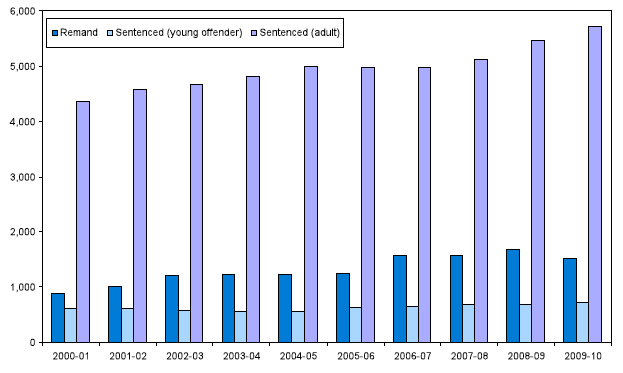
6. The sentenced population continues to show a steady increase of 5 per cent overall, reaching 6,441 in 2009-10, mainly due to increases in the medium term population with sentences of six months to four years. The short term population with sentences under 6 months fell notably over the past year to 439, a drop of just over 10 per cent, continuing the downward trend observed since 2006-07 ( Table 3).
7. Prisoners on remand or recalled from licence or supervision constitute a relatively small proportion of the prison population, although these categories have shown disproportionate increases over the past decade. The picture has become somewhat more complex over the past year. The current rate of growth for the recall population is in line with the general sentenced population at 4 per cent, reaching 621 during 2009-10. On the other hand, there is a drop in the remand population of nearly a tenth to 1,522 ( Table 1).
8. Untried prisoners form the bulk of the remand population, 1,170 compared to 352 for remand prisoners who have been convicted but not sentenced. Remand receptions have been drifting downward over the past few years, and it is likely that the current focus on achieving the 26 week target for dealing with criminal cases in sheriff summary and district courts will have contributed to the fall in the population of untried prisoners. However, while the untried population has gone down over the past year by nearly a fifth, the population of convicted remand prisoners awaiting sentencing shows an increase of about a third, and further work will need to be carried out to establish whether there is a decrease in the time spent on remand at pre-trial stage which is being offset by an increase in the time spent on remand between conviction and sentencing.
9. The drop in the remand population is particularly notable for women, with a fall of just over one fifth for both untried prisoners and those convicted but not yet sentenced. This has led to a slowing down of the rate of increase relative to men, although this is partially offset by a higher rate of increase in the female sentenced population (15 per cent compared to 4 per cent for men). During 2009-10, the average daily population increased by 2 per cent to 7,540 for men, and by 3 per cent to 424 for women ( Table 1).
10. The daily population can fluctuate quite substantially compared to the average over the year. As in 2008, there were particularly high population levels during 2009, with a record peak of 8,248 in early July ( Table 2).
Population profile
11. The prison population on 30 June 2009 was 8,183, of which 95 per cent were men ( Table 4). The age profile of women prisoners tends to be somewhat older than that for men (Chart 3).
Chart 3 Age distribution of prisoners by sex: 30 June 2009
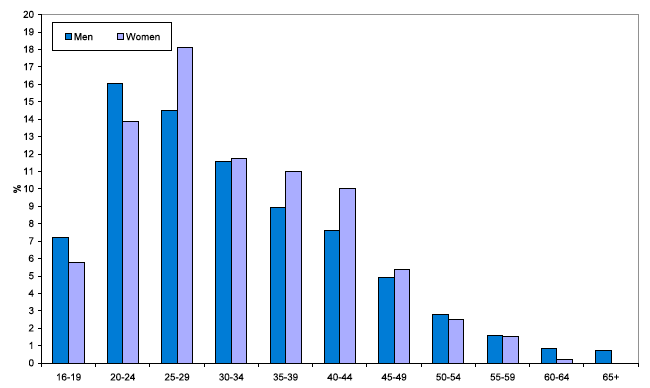
12. Just over half of the prison population (57 per cent) had a medium supervision level, and 9 per cent had a high supervision level. The remaining 34 per cent had a low level of supervision ( Table 4). See Section 5 for details on supervision levels.
13. The crime category with the largest population of sentenced prisoners on 30 June 2009 was non-sexual violent crime (36 per cent), followed by the other crimes category (21 per cent). This category consisted mainly of drugs-related crimes, which make up 14 per cent of the total ( Table 5).
14. The imprisonment rate per 100,000 population is highest for Glasgow and Dundee (351), followed by West Dunbartonshire (315). Inverclyde, North and East Ayrshire also have relatively high imprisonment rates (Chart 4). Aberdeenshire has the lowest rate (52), followed by East Dunbartonshire (61), Orkney (67), East Lothian and East Renfrewshire (69 for both) ( Table 6).
Chart 4 Imprisonment rate per 100,000 population (Scotland): June 2009
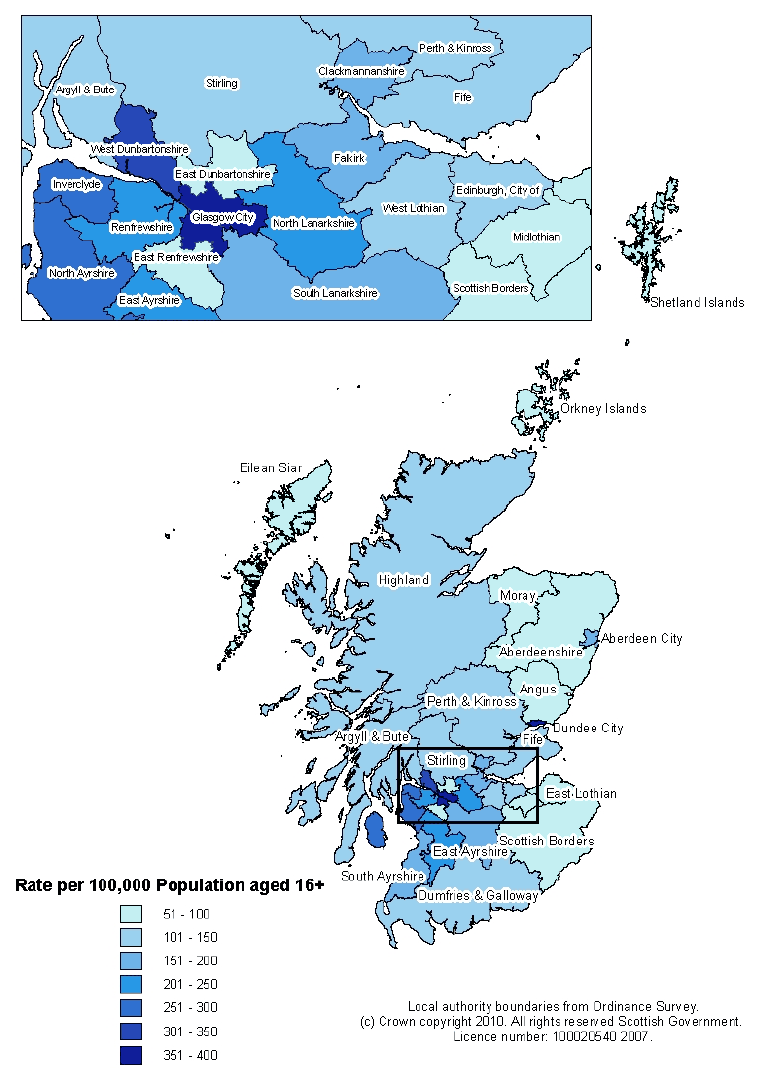
Home Detention Curfew
15. Release on Home Detention Curfew ( HDC) for low risk prisoners nearing the end of their sentence started in July 2006. Since implementation, the daily population of prisoners on HDC has risen from about 300 during 2007 to just under 400 during 2009 (Chart 5).
16. The average daily population on HDC during 2009-10 was 371, a slight increase of 1 per cent over the previous year. The number of releases from prison on HDC was 1,885, a drop of 8 per cent compared to the previous year ( Table 8).
Chart 5 Average daily population on Home Detention Curfew: April 2007 to March 2010
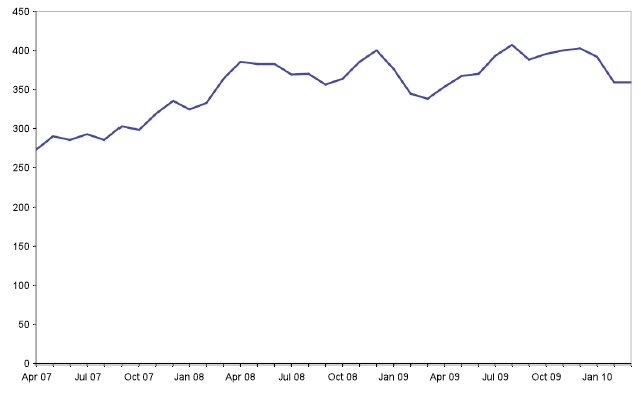
Receptions
17. Receptions tend to show some year on year variation (Chart 6), but the overall trend has been consistently downward since 2006-07, the most recent figures showing a fall of 6 per cent. Remand receptions have on the whole been drifting downward since 2006-07, with a notable drop of 7 per cent over the past year ( Table 9).
18. A general downward drift can also be seen in sentenced receptions since 2002-03. This is primarily due to marked and consistent falls in the number of receptions for fine default, largely as a result of the use of Supervised Attendance Orders as an alternative to custody for non-payment of fines ( Table 9). Direct sentenced receptions have in general drifted upward over the past 10 years, although the figures for 2009-10 show a 4 per cent fall over the past year to 14,056 ( Table 12).
Chart 6 Prison receptions by custody type: 2000-01 to 2009-10
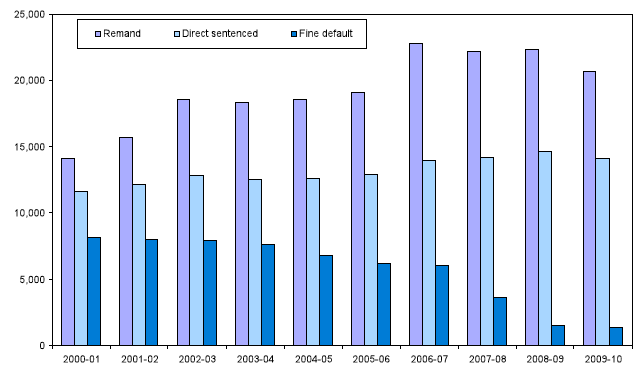
Direct sentenced receptions
19. The bulk of the general rise in direct sentenced receptions over the past 10 years is due to increasing volumes of relatively low-tariff crimes and offences. These include crimes against public justice, handling offensive weapons, common assault and breach of the peace. The rate of increase has been particularly marked since 2003-04, although, as noted above, the recent figures indicate a potential degree of change in this medium-term trend ( Table 13).
20. In terms of types of crimes and offences, the most notable areas of recent change are receptions for drugs related crimes (up by 10 per cent to 1,463), handling offensive weapons (down by 8 per cent to 1,075), crimes of dishonesty (down by 6 per cent to 3,709, with two thirds of the drop due to decreased receptions for shoplifting and theft of/from a motor vehicle), common assault (down by 4 per cent to 1,956), and motor vehicle offences (down by 23 per cent to 687) ( Table 13).
21. The average sentence length has fluctuated somewhat over the past 10 years, with the most recent figures showing a consistent increase over the past three or four years to a peak of 343 days ( Table 14). This represents an increase of 6 per cent over the previous year (Chart 7).
Chart 7 Average sentence imposed (days): 2000-01 to 2009-10
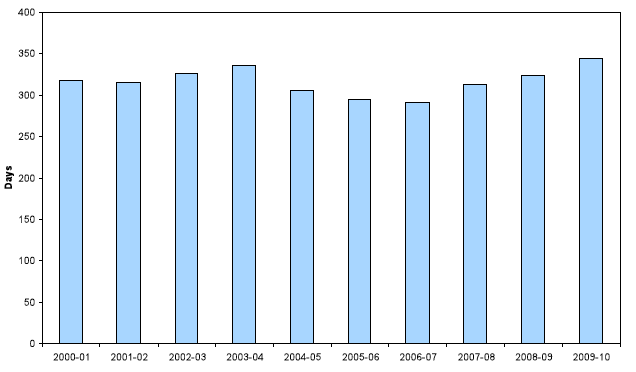
22. The shift in balance between less serious and more serious crimes highlighted in §19 appears to have had a short term impact on the average sentence length between 2003-04 and 2006-07. However, over the past 10 years there have also been increases in receptions for crimes of violence of over a third. These tend to result in heavier sentences and will therefore have a greater impact on the prison population in the longer term ( Table 13).
23. The sentence category with the largest increase is for sentences between six months and four years, where there was a 15 per cent increase to 7,083 in 2009-10 compared to the previous year ( Table 14). This category also accounts for half of all direct sentenced receptions.
International comparisons of prison population
24. In terms of prison population per 100,000 population, Scotland ranked thirteenth highest with 158, similar to England and Wales (156) and Hungary (153) (Chart 8). This is higher than most other EU countries, but substantially lower than the US, the Russian Federation and the Baltic states ( Table 17). Comparisons of the prison population in different jurisdictions should be treated with caution due to the different justice systems and recording rules in operation.
Chart 8 Imprisonment rate per 100,000 population by jurisdiction: 2009

There is a problem
Thanks for your feedback